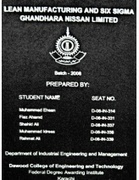Apr 19 2013
A Pakistani student’s project report on the Ghandara Nissan plant
See on Scoop.it – lean manufacturing

If you have always wanted to visit the Ghandara Nissan plant in Pakistan, this 170-page report is the next best thing, with numerous photographs of the shops.
The title implies that the plant practices both Lean Manufacturing and Six Sigma, but it is misleading.
It contains a long, general, and loose description of Six Sigma, but no evidence of it being used at Ghandara Nissan.
See on www.scribd.com

Apr 23 2013
Forget Excel: This Was Reinhart and Rogoff’s Biggest Mistake | The Atlantic
See on Scoop.it – lean manufacturing

“For an economist, the five most terrifying words in the English language are: I can’t replicate your results. But for economists Carmen Reinhart and Ken Rogoff of Harvard, there are seven even more terrifying ones: I think you made an Excel error.”
While not a story about manufacturing, it is a cautionary tale that manufacturing professionals who use Excel should ponder.
It is about two economists from a prestigious institution whose sweeping conclusions have been leading foreign governments to adopt disastrous policies and fueled the argument in favor of the same policies in the US.
Reviewing the Harvard paper, researchers Thomas Herndon, Michael Ash and Robert Pollin have discovered that Reinhart and Rogoff had selectively excluded data, calculated averages in “unusual ways,” and made a mistake in an Excel calculation.
On the face of it, the general sloppiness of the work would be forgivable in a summer intern, but the Excel error should give us pause. When inputting the range of a sum, they didn’t drag the cursor down far enough and left five rows out.
With Excel, this kind of error is easy to make and difficult to detect. In spreadsheets generated by others, I have found products with no sales showing positive revenues, and formulas with exponents applied to the wrong parameters. And I suspect others may have found errors in my own.
Following are a few recommendations that may protect you from egg on your face:
See on www.theatlantic.com
Share this:
Like this:
By Michel Baudin • Press clippings 4 • Tags: Carmen Reinhart, Excel, Harvard, Kenneth Rogoff, Thomas H. Herndon